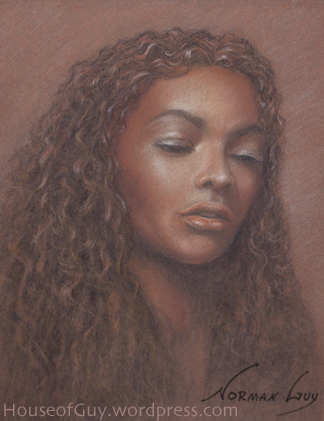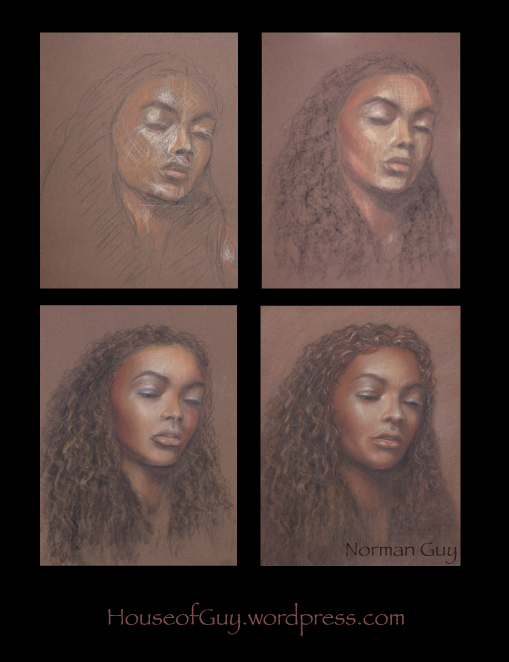

• • •
Her name was Alana. She was a blended beauty of Japanese American and African American descent.
This drawing did not start out as a portrait of her — it was supposed to be a study of an imaginary young woman with brown skin and curly hair. I had not yet decided what she would look like. But as I drew, the portrait took on a life of its own.
A vaguely familiar face that I could not place slowly emerged. A nose with a low bridge and small nostrils. Strong, heavy, glossy curly hair. Eyes that are common to indigenous Asians or South Americans. A full lower lip.
As the drawing evolved, I realized I was unconsciously drawing a memory. I was drawing Alana.

I used 3 colors— black, sanguine (reddish-brown) and white—on brown toned paper. This three color approach, known as “trois crayons,” is a centuries old technique.
However, the drawing was from memory and — memory being what it is — the portrait is more likely an interpretation of Alana’s face rather than an actual likeness. But I do remember her bright and cheerful personality — and an underlying pensiveness.
The root cause of Alana’s pensiveness was how her relatives related to her “biracial” Afro-Asian / Black Japanese / Blasian heritage. Some of her African-American relatives praised her for her “exotic” appearance, light skin, and her “good” hair. But, ironically, her “good” hair and light skin was not quite good enough for some of her Japanese American relatives, who suggested that she straighten her hair to be more like “Japanese hair,” and to stay out of the sun so that her skin would not get any darker.
The message from both sides of her family was clear — light skin tones and straight hair are considered to be desirable traits, while darker skin tones and curly or wiry hair — especially hair that is common to indigenous Africans — are considered to be undesirable traits.
Alana was fine as she was, of course.
But she did not know how to relate to being prized as the “exotic” beauty by some of her African American relatives, who were ( through no fault of their own) the unfortunate casualties of internalized racism.
And she did not know how to accept her physical traits that did not conform to the traditional Japanese ideal of beauty embraced by some of her Japanese American relatives.
Consequently, some of her relatives from both sides of her family (unknowingly and unintentionally) made her feel ashamed of her African heritage — and severely damaged and distorted her sense of self-identity and self-worth.
I don’t know what happened to Alana. It has been many years since I last saw her.
I do know that Alana was on the path to embracing her blended appearance, vowing not to conform to society’s or anyone’s idealization or expectation of beauty. Moreover, she was fiercely rejecting notions of being “exotic,” inferior — or superior — because of her mixed heritage.
Alana was finally accepting what she knew all along — that she was fine just as she was: brown skin, curly hair, Asian eyes. Bicultural and a little bit bilingual. In a world where many embrace and insist upon a single ethnic identity — she would bravely choose to be comfortably blended.
• • •

Tonight I witnessed the fourth and final total lunar eclipse of the ongoing lunar tetrad. During the eclipse, the full Harvest Moon became a smokey copper brown — a Blood Moon. But because it was at its closest point to Earth in its orbit, it was also a perigee full moon — or a “supermoon.” So on this night, most of the world experienced a super Harvest Blood Moon.
• • •
copyright © 2014–2019 by Norman Guy. All rights reserved.